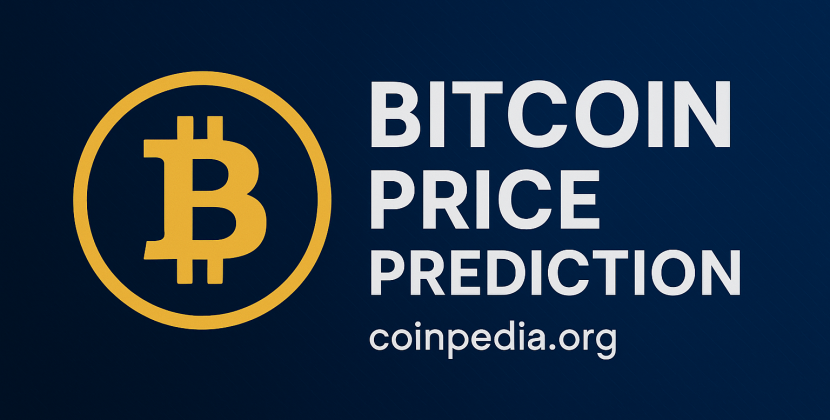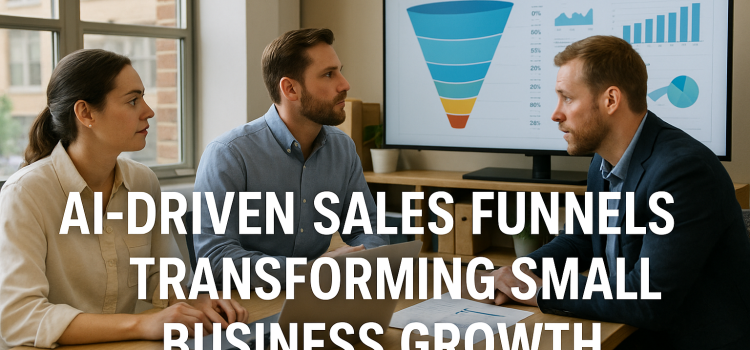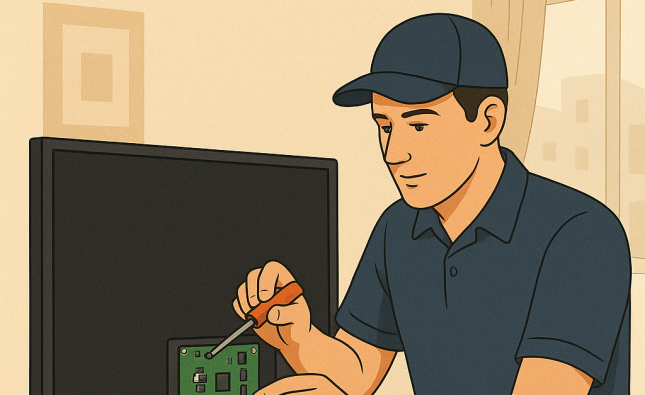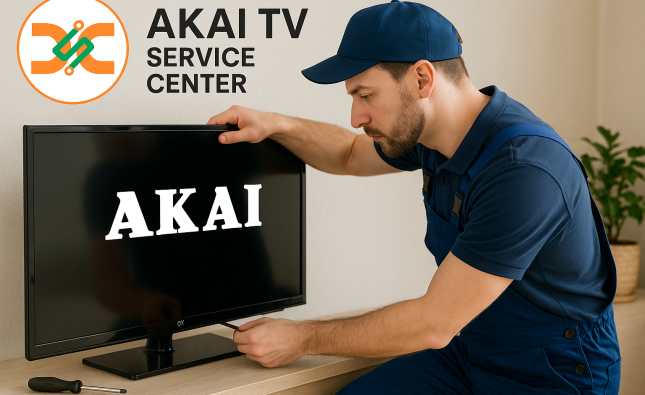
Introduction
A decade ago, building a sales funnel meant juggling landing-page plug-ins, email blasts, and guess-heavy ads. Today, affordable artificial intelligence stitches every step together, predicting which visitor will buy, writing personalized emails, and even timing discounts to the minute a shopper is ready. For small businesses, these once-enterprise powers deliver big-league growth on garage-startup budgets.
This guide explains, in simple wording, how AI-driven funnels work and how owners can install them without hiring data scientists. You will see real tools, pricing hints, and quick-start tips that turn curious clicks into loyal customers—while you sleep.
In this article, you will learn what an AI-driven sales funnel is, why it matters, and how it boosts small business growth. You will also see how AI helps at each stage of the customer journey, which tools to use, and best practices to follow.
What Is an AI-Driven Sales Funnel?
An AI-driven sales funnel is a structured path that guides a potential customer from awareness of your brand to making a purchase. Traditional funnels rely on manual tasks like sending emails or posting on social media.
It uses data from website visits, email opens, social media interactions, and past purchases. Predictive analytics help the system guess what the customer needs next.
For example, if someone reads a blog post about your product, AI can send a follow-up email with a special offer. This way, your business stays top of mind without you writing each message. AI-driven funnels also adapt in real time. If metrics show a drop in engagement at one stage, the system can change its approach—perhaps by offering a discount or sharing a customer success story. This dynamic, data-based method boosts small business growth by improving conversion optimization and lead nurturing.
An AI-driven sales funnel uses machine-learning models at each customer journey stage:
- Attract – AI targets ads to look-alike audiences.
- Capture – Chatbots qualify leads 24/7.
- Nurture – Predictive email sequences adapt topics to reader behavior.
- Convert – Dynamic pricing engines nudge hesitant carts.
- Delight – AI sentiment tools flag at-risk customers for personal follow-up.
Automation saves time; learning loops boost accuracy the more data flows.
Why Small Businesses Should Care
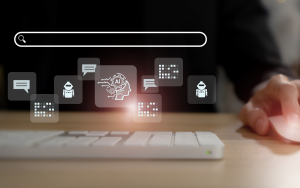
Lower Cost Per Lead
Smart bidding tools such as Google Performance Max cut wasted impressions by learning which keywords convert fastest.
Personal Touch at Scale
A solo founder can serve hundreds of prospects with chatbots writing brand-toned answers instantly, raising reply speed and conversion trust.
Data-Rich Decisions
Dashboards reveal funnel leaks—maybe emails open well but checkout stalls. AI pinpoints friction so you fix one link instead of guessing across the chain.
Middle of Funnel: Engaging Leads
Once prospects know about your business, you move them into the MOFU stage. Here, you nurture leads with helpful content. AI-driven email automation platforms segment your audience based on behavior. A prospect who viewed multiple product pages gets a demo invitation. Another who attended a webinar receives a follow-up guide.
Machine learning models predict which content offers will convert best. They test different subject lines, email copy, and send times. Over time, the system learns which variants yield the highest open and conversion rates. This A/B testing at scale refines your approach without manual trial and error.
Conversational AI chatbots handle detailed questions too. Advanced bots integrate with customer data to personalize interactions. They can check order status, schedule calls, or suggest resources. This level of service keeps leads engaged and moves them closer to purchase.
Benefits of AI-Driven Sales Funnels
AI-driven sales funnels offer clear advantages over manual methods. First, they save time. Software can send thousands of emails, ads, and messages automatically. You only need to set up rules and monitor performance. This leaves you free to focus on product development and customer support.
Second, AI improves targeting. Predictive analytics analyze past behavior to identify the most promising leads. Instead of sending the same message to everyone, AI personalizes content. A visitor who looked at your service pricing page might get a demo link. Someone who downloaded an ebook may receive a case study. Personalization at scale boosts engagement and conversion rates.
Third, AI-driven sales funnels reduce errors. Humans can mistype an email or miss a follow-up. AI follows rules precisely and never forgets a step. It also tracks every interaction. This data helps you spot weak spots in the funnel and correct them quickly.
Tools for Building AI-Driven Sales Funnels
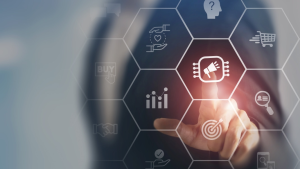
Several platforms help small businesses implement AI-driven funnels. Here are some popular tools:
HubSpot
HubSpot’s marketing hub includes AI-powered email automation, chatbots, and lead scoring. It integrates CRM data for personalized outreach. A drag-and-drop interface lets you build funnels without coding knowledge. HubSpot’s free tier covers basic features, while paid plans start around $50 per month.
ActiveCampaign
ActiveCampaign combines email marketing with CRM and machine learning. Its predictive sending feature selects optimal send times for each contact. Lead scoring and site tracking help identify hot leads. Plans start at $15 per month for small businesses.
Klaviyo
Klaviyo focuses on e-commerce brands. AI predicts customer lifetime value and churn risk. It offers advanced segmentation based on purchase history and browsing behavior. Automated flows handle welcome series, cart abandonment, and re-engagement. Pricing begins at $20 per month, based on email list size.
Drift
Drift specializes in conversational marketing. Its chatbots qualify leads in real time and book meetings automatically. The platform uses AI to recommend next-best actions. Drift integrates with CRMs like Salesforce. Pricing is higher, but small businesses can start with limited chat features.
Core AI Tools and Their Funnel Roles
| Funnel Stage | Affordable AI Tool | Price/Month | Key Feature | Skill Needed |
|---|---|---|---|---|
| Traffic | AdCreative.ai | $29 | Auto-generates ad images/text | Basic ad setup |
| Capture | Tidio Chatbot | $0–$39 | GPT-powered lead qualifying | Drag-and-drop flow |
| Nurture | MailerLite AI | $29 | Predictive send time & copy | Email list CSV |
| Convert | ReConvert + Shopify AI | $29 | Personalized upsell offers | Shopify store |
| Retain | Zendesk Sentiment | $19/seat | Flags negative tone tickets | Support login |
Start with one stage, then layer others as revenue grows.
Building Your AI Funnel Step by Step
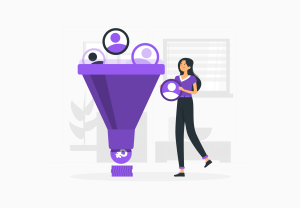
1. Map a Simple Customer Path
Ad → Landing Page → Email Drip → Checkout → Feedback Survey.
Write this flow on paper first; AI tools plug into each step later.
2. Collect Clean Data Early
Use one lead form for name, email, top goal. Standard fields let models learn faster. Store in Google Sheets or a free CRM like HubSpot Starter.
3. Train Chatbot FAQs
List ten common questions and helpful answers. Feed them to your chatbot so it starts “smart” before machine learning fine-tunes replies.
4. Launch Micro-Ads With AI Creative
Generate three image variants and three headlines. Spend $10/day for five days. Pause the lowest click-through ad; scale the winner.
5. Set Predictive Email
Most AI email platforms ask for past open data. If you have none, start with default times, let it learn for two weeks, then enable “Smart Send.”
6. Enable Cart-Abandon Nudges
Install a plugin that offers AI-timed coupons only to users with high exit probability—protecting margin by not discounting everyone.
Personalization Tactics That Convert

Dynamic Content Blocks
E-commerce owners can show vegan products to visitors who browsed plant-based recipes, all in one template.
Recommendation Carousels
Tools like Recombee suggest add-on items based on look-a-like customer baskets, boosting average order value without hard sells.
Predictive Lead Scoring
CRMs assign each lead a score 0–100. Call high-score leads first; let nurture emails warm low-score ones—saves phone time.
Measuring Success: Key AI Funnel Metrics
| Stage | Metric | Good Benchmark |
|---|---|---|
| Traffic | Cost per click (CPC) | <$1 niche, <$0.30 broad |
| Capture | Lead conversion % | 8–15 % landing page |
| Nurture | Email open rate | 35 % + with smart send |
| Convert | Cart-abandon recovery | ≥20 % rescued |
| Retain | Repeat purchase rate | 25 % 6-month window |
Review weekly; AI platforms often suggest tweaks automatically.
Real-World Mini Case Studies
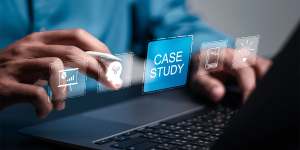
Handmade Soap Shop
Problem: Owner spent evenings answering Instagram DMs.
AI Fix: Added Tidio chatbot trained on fragrance notes.
Result: Response time fell to 5 seconds, lead captures doubled, sales up 30 %.
B2B SaaS Startup
Problem: Low demo bookings.
AI Fix: MailerLite predictive emails with case-study content matched to user role.
Result: Demo conversions rose from 6 % to 14 % in six weeks.
Budget Planner: First-Year AI Funnel
| Item | Monthly Cost | Annual Total |
|---|---|---|
| AdCreative.ai | $29 | $348 |
| Tidio Chatbot (Growth) | $39 | $468 |
| MailerLite AI Tier | $29 | $348 |
| Shopify Upsell App | $29 | $348 |
| Misc. AI analytics | $20 | $240 |
| Total | $146 | $1 ,752 |
Even tiny shops often recoup that in one additional sale per month.
Avoiding Common Pitfalls
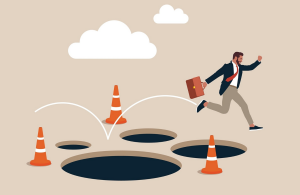
Data Overload
Too many dashboards create “analysis paralysis.” Pick one north-star metric per stage.
Robotic Tone
Feed AI examples in your voice. Review first 20 outputs manually to ensure warmth.
Privacy Risks
Store leads in GDPR-compliant tools. Add a checkbox for marketing consent and clear privacy copy.
Future Trends to Watch
- Voice-assistant funnels—AI booking calls via natural speech.
- Video AI—Personalized product walkthroughs auto-generated with customer name on screen.
- On-device learning—Edge AI protects data by processing recommendations locally.
Early adopters gain edge as customer expectations rise.
Conclusion
AI-driven funnels shrink guesswork and multiply small-business growth by automating ads, chat, email, and checkout nudges with learning loops that get sharper daily. You don’t need a PhD—just clear goals, clean data, and one affordable tool per funnel stage. Start small: map your funnel, add an AI chatbot, and watch response times and sales climb. Build on that success with predictive email and smart upsells.
Tools like HubSpot, ActiveCampaign, Klaviyo, and Drift make it easy to start without deep technical skills. With these strategies, you can build a smart sales machine that adapts over time and drives consistent results.
Call to Action: Choose one AI tool from this guide, activate its free trial today, and monitor your key funnel metric for two weeks—your data-smart growth journey starts now.


